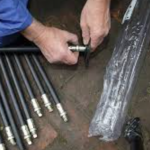Although it may seem that drug making is as old as humankind, this is not quite true. High-quality, well-researched drug making, as we now understand the term, rather than simply gathering herbs and observing their effects, is a modern invention. Snake oil remedies and quack remedies that were popular in the 1800s have now been replaced by carefully-researched drugs.

Drugs are constantly being invented because curious scientific thinkers wonder what is available in nature to relieve the woes of humanity that can be tested and refined and made more effective. A tremendous amount of research goes into producing the new drugs we see all around us all the time. In fact, it’s quite amazing how the whole process of drug manufacturing works.
Long Years, High Costs
Making pharmaceutical drugs is a complex process and can take up to ten years from discovery to the marketplace if they ever get there at all. Clinical trials by themselves can last up to seven years. In fact, the average cost to develop a first-rate drug two years back in 2016 was estimated in billions, not millions.
Due to how long it takes to research and develop a drug, there is plenty of time for researchers to have to deal with all sorts of problems. Problems arise if key researchers may leave the project, requiring a frantic search for new talent, which is not easy considering the high degree of knowledge and skill expected from the new candidate. Problems also arise when grants end abruptly and entire labs may have to be moved to a new location. If the drug is in animal testing, for example, a professional group has to be engaged in biological transport as any contamination in the biological samples could set the project back many years and shoot up the costs.
The Process of Drug Discovery
Drug discovery is now an integral part of pharmacology, medicine, and biotechnology. Scientists are forever on a quest to find new medications. Once a suitable compound has been identified as having medicinal qualities, the process of drug development from discovery to clinical trials begins.
According to the U.S. Food and Drug Administration, there are five phases of drug research:
First, there is the discovery of a compound that it can be researched in the laboratory.
Second, there is preclinical research. The drug undergoes laboratory analysis and may be tested on animals to find out if it’s safe for use on or in a living organism.
Third, there is clinical research. Since the drug has been found to be safe on animals, it is now tested by volunteers, whose response to the drug are carefully monitored and evaluated. There are three phases here, known as Phase I, II, and III. In Phase I, the drug is tested on healthy volunteers to see if its safe for human beings. Volunteers are given multiple doses at different dose-ranges. In Phase II, the drug is tested on patients who need the benefits of the drug. The drug is assessed for efficacy. If, for instance, it’s a muscle relaxing drug, researchers want to know how well it relaxes inflammation of muscle tissue. The drug is also assessed for side-effects. Maybe, the muscle-relaxant drug does heal tense muscles, but it may make the user feel nauseous or become groggy for several hours. In phase III, the final version of the drug is tested on patients to make sure that it is efficacious, effective, and safe.
Fourth, there is the phase of FDA review. This is when FDA scientists cross-check to make sure that everything the drug manufacturer claims about the drug can be replicated in their own government labs.
Fifth, the drug is reviewed after it is released to the public. FDA officials want to know if the drug creates any side effects that were not detected due to a small sample size in the manufacturer’s facilities or the FDA’s labs.
The Quest for Constant and Never-Ending Improvement.
In conclusion, new drugs are produced to find a better solution to an existing health problem. Similar to software engineers who are always looking to improve the code to come up with a new, better version, drug makers are always looking for a better solution even if there are plenty of available already.
For example, many people suffer from tension headaches. Although there are already many headache-relieving products on the market, a new one has recently been released, a non-narcotic analgesic called Fiorcet, which combines caffeine, acetaminophen, and butalbital. These ingredients in the right dosage work synergistically to quickly relieves pain and fever and rapidly make tension headaches disappear.













